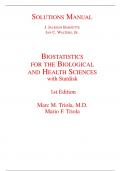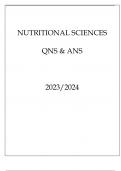SOLUTIONS MANUAL
J. JACKSON BARNETTE
IAN C. WALTERS, JR.
BIOSTATISTICS
FOR THE BIOLOGICAL
AND HEALTH SCIENCES
with Statdisk
1st Edition
Marc M. Triola, M.D.
Mario F. Triola
, Contents
1 Introduction 1
2 Describing, Exploring, and Comparing Data 7
3 Probability 63
4 Discrete Probability Distributions 89
5 Normal Probability Distributions 109
6 Estimates and Sample Sizes with One Sample 167
7 Hypothesis Testing with One Sample 201
8 Inferences from Two Samples 235
9 Correlation and Regression 277
10 Multinomial Experiments and Contingency Tables 311
11 Analysis of Variance 343
12 Nonparametric Statistics 359
13 Life Tables 417
,Chapter 1: Introduction 1
Chapter 1. Introduction
1-2 Types of Data
In Exercises 1 – 4, determine whether the given value is a statistic or a parameter.
1. Statistic, since 12 males (the sample size of males) is a characteristic of a sample.
2. Statistic, since 3.8 (the sample mean) is a characteristic of a sample of Canadian geese.
3. Statistic, since 226 m (the sample mean) is a characteristic of a sample of frigate birds.
4. Parameter, since 2.7 years (the population mean) is a characteristic of the population of cloned sheep.
In Exercises 5 – 8, determine whether the given values are from a discrete or continuous data set.
5. Discrete, since the number of birds must be in the form of whole numbers, a fraction of a bird is not possible.
6. Continuous, since length in inches of hummingbirds can take on any value over a continuous span.
7. Discrete, since the number of families having guns in their homes must be in the form of whole numbers; a
fraction of a home is not possible.
8. Continuous, since head width in inches can take on any value over a continuous span.
In Exercises 9 – 16, determine which of the four levels of measurement (nominal, ordinal, interval ratio) is most
appropriate.
9. Ratio, since there are equal intervals and a natural starting point of 0 inches.
10. Ordinal, since racing ability can be ordered low to high, but the actual difference in ability between the
observed points cannot be determined.
11. Interval, since body temperatures, either measured on a Fahrenheit or Centigrade scale, have equal intervals, but
do not have a natural starting point of 0.
12. Nominal, since case numbers would be like labels, they identify but have no ordered property. If the case
numbers were in sequence of when they happened over time, they might have an ordinal property.
13. Nominal, since the measure is used as a label for a category and the category does not have any ordinal
property.
14. Nominal, since social security numbers are labels with not orderable property.
15. Ratio, since the number of manatees killed by boats has a natural 0 starting point.
16. Nominal, since zip codes are like labels and they have no ordered property. There is a systematic way of
assigning them, but that does not provide a way to order them in any way that would be meaningful.
In Exercises 17 – 20, identify the (a) sample and (b) population. Also determine whether the sample is likely to
be representative of the population.
17. This would be a sample that is likely not representative of the population of rainbow trout, but it could be
representative of rainbow trout in the stream where she is netting the trout.
, 2 Chapter 1: Introduction
18. This would be a sample that is likely not representative of the population of persons with attitudes or
perceptions about health, but it might be representative of those who read the Florida newspaper.
19. This would be a sample that would likely be representative of a population from which the sample was drawn.
20. This would be a sample that is likely not representative of adult Americans, but it might be representative of the
persons the graduate student knows.
1-3 Design of Experiments
In Exercises 1 – 4, determine whether the given description corresponds to an observational study or an
experiment.
1. Drug Testing Experiment, since the patients are being treated or exposed to a treatment, in this case Lipitor.
2. Treating Syphilis Observation, since patients are observed to determine health condition, but not treated in
such a way to modify them. However, this could be part of an experiment if they are compared on the same
outcome variables with a treated group.
3. Quality Control Observation, since the amount of aspirin is observed in each tablet, they are not exposed to any
treatment.
4. Magnetic Bracelets Experiment, since the use of the bracelets is a treatment that may result in lower likelihood
of suffering from the effects of motion sickness.
In Exercises 5 – 8, identify the type of observational study (cross-sectional, retrospective, prospective).
5. Medical Research Retrospective, since the study focus is on what has happened in a period of the past (five
years) for head injury patients.
6. Psychology of Trauma Prospective, since the study focus is on what happens to siblings of victims of the
World Trade Center attacks in a period after the attacks occurred.
7. Flu Incidence Cross-sectional, since the study focus is on what happened at a specific time period.
8. Deer Encounters Retrospective, since the study focus is on what happened relative to damage caused by
vehicles hitting deer in a period of the past (10 years).
In Exercises 9 – 20, identify which of these types of sampling is used: random, systematic, convenience, stratified,
or cluster.
9. Aspirin Usage Convenience, since the researcher asks those who enter the clinic for treatment.
10. Health Survey Selection Systematic, since every ith, in this case every thousandth, name/person in a list is
selected for the sample.
11. Telephone Polls Random, since telephone survey respondents were selected at random from a list of phone
numbers; each phone number would have the same chance of being selected. However, we need to exercise
some caution in calling this random. When a large majority of potential survey respondents had phones and
researchers had access to the phone numbers, these types of surveys were often considered random. However,
with changes like “no call lists”, unlisted numbers, phones that can be programmed to screen out unrecognized
calls, and individuals who have made cell phones their phone of choice and have dropped land line phones,
random dialing of phone numbers is less likely to provide a representative sample than has been the case in the
past.






